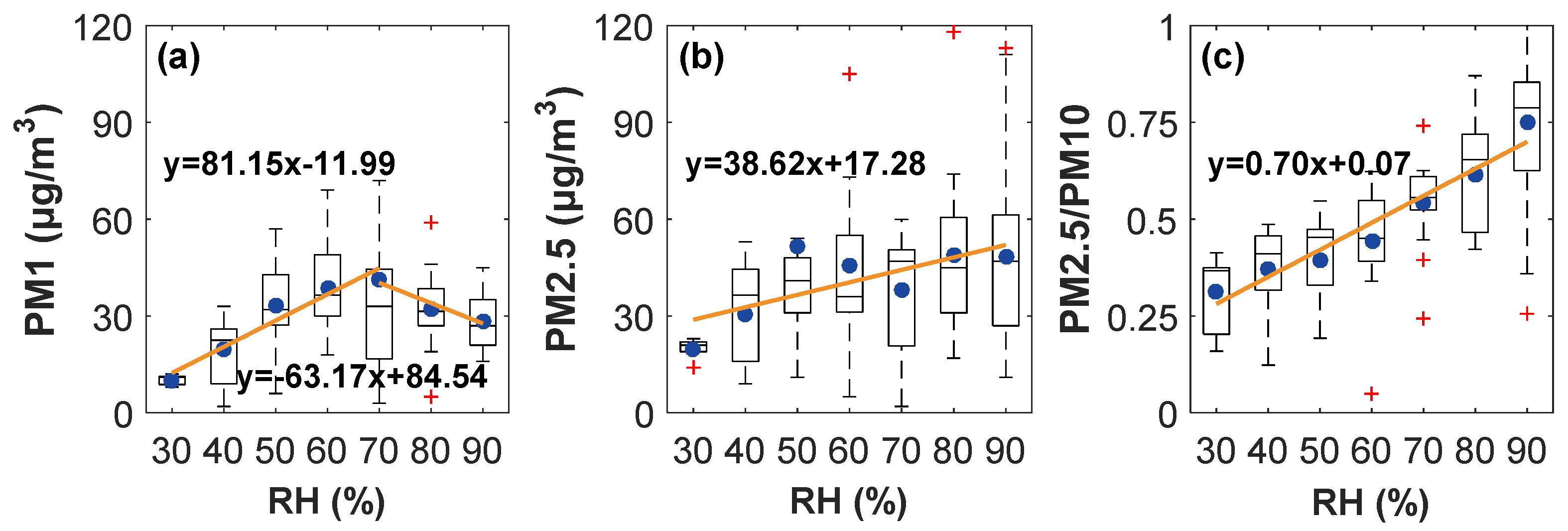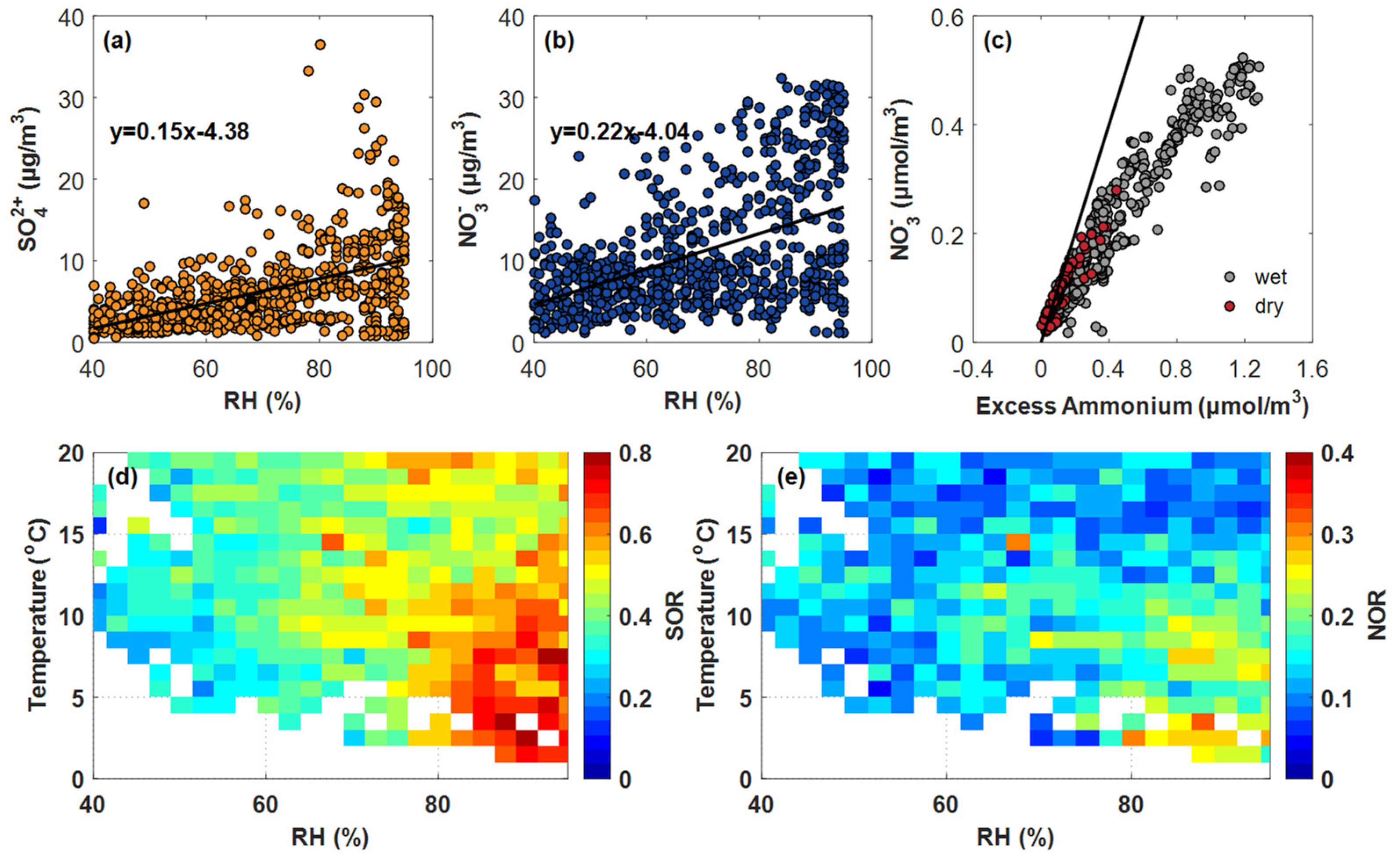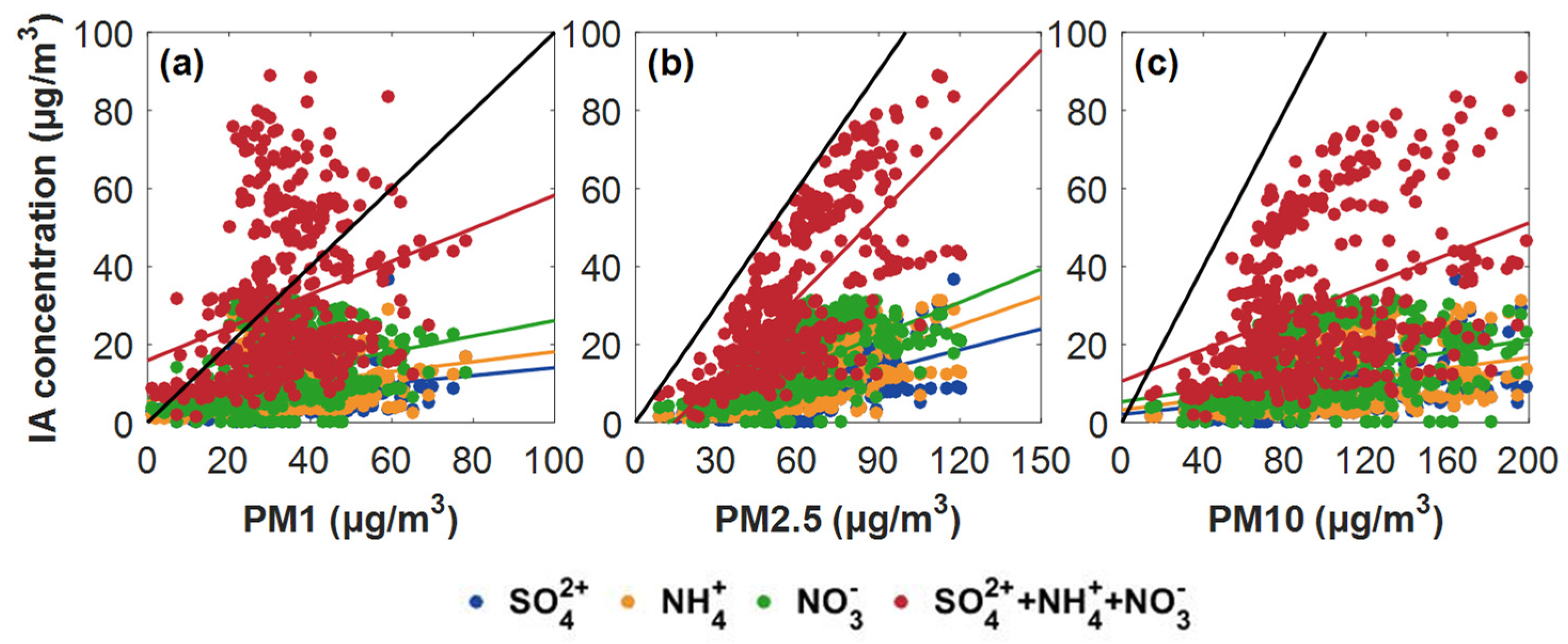Roles of Relative Humidity in Aerosol Pollution Aggravation over Central China during Wintertime
Abstract
1. Introduction
2. Data and Methods
2.1. Data
2.2. Method
2.2.1. Parameterization of Scattering Hygroscopic Growth
2.2.2. Evaluation of Secondary Aerosols
3. Results and Discussion
3.1. Overview
3.2. Aerosol Scattering Hygroscopic Growth
3.3. Secondary Aerosol Formation
4. Conclusions
Author Contributions
Acknowledgments
Conflicts of Interest
References
- Pan, Z.; Mao, F.; Gong, W.; Min, Q.; Wang, W. The warming of tibetan plateau enhanced by 3d variation of low-level clouds during daytime. Remote Sens. Environ. 2017, 198, 363–368. [Google Scholar] [CrossRef]
- Twomey, S.A.; Piepgrass, M.; Wolfe, T. An assessment of the impact of pollution on global cloud albedo. Tellus B 1984, 36, 356–366. [Google Scholar] [CrossRef]
- Mao, F.Y.; Pan, Z.X.; Henderson, D.S.; Wang, W.; Gong, W. Vertically resolved physical and radiative response of ice clouds to aerosols during the indian summer monsoon season. Remote Sens. Environ. 2018, 216, 171–182. [Google Scholar] [CrossRef]
- Lu, X.; Mao, F.Y.; Pan, Z.X.; Gong, W.; Wang, W.; Tian, L.Q.; Fang, S.H. Three-dimensional physical and optical characteristics of aerosols over central china from long-term calipso and hysplit data. Remote Sens. 2018, 10, 314. [Google Scholar] [CrossRef]
- IPCC. Climate Change 2007: The Physical Science Basis; Contribution of Working Group I to the Fourth Assessment Report of the Intergovernmental Panel on Climate Change; Cambridge University Press: New York, NY, USA, 2007. [Google Scholar]
- IPCC. Climate Change 2013: The Physical Science Basis; Contribution of Working Group I to the Fifth Assessment Report of the Intergovernmental Panel on Climate Change; Cambridge University Press: New York, NY, USA, 2013. [Google Scholar]
- Dominici, F.; Peng, R.D.; Bell, M.L.; Pham, L.; McDermott, A.; Zeger, S.L.; Samet, J.M. Fine particulate air pollution and hospital admission for cardiovascular and respiratory diseases. J. Am. Med. Assoc. 2006, 295, 1127–1134. [Google Scholar] [CrossRef] [PubMed]
- Gauderman, W.J.; Avol, E.; Gilliland, F.; Vora, H.; Thomas, D.; Berhane, K.; McConnell, R.; Kuenzli, N.; Lurmann, F.; Rappaport, E.; et al. The effect of air pollution on lung development from 10 to 18 years of age. N. Engl. J. Med. 2004, 351, 1057–1067. [Google Scholar] [CrossRef] [PubMed]
- Wang, W.; Mao, F.Y.; Gong, W.; Pan, Z.X.; Du, L. Evaluating the governing factors of variability in nocturnal boundary layer height based on elastic lidar in wuhan. Int. J. Environ. Res. Public Health 2016, 13, 1071. [Google Scholar] [CrossRef] [PubMed]
- Wang, W.; Gong, W.; Mao, F.Y.; Zhang, J.Y. Long-term measurement for low-tropospheric water vapor and aerosol by raman lidar in wuhan. Atmosphere 2015, 6, 521–533. [Google Scholar] [CrossRef]
- Liu, B.M.; Ma, Y.Y.; Gong, W.; Zhang, M. Observations of aerosol color ratio and depolarization ratio over wuhan. Atmos. Pollut. Res. 2017, 8, 1113–1122. [Google Scholar] [CrossRef]
- Huang, K.; Zhuang, G.; Wang, Q.; Fu, J.; Lin, Y.; Liu, T.; Han, L.; Deng, C. Extreme haze pollution in beijing during january 2013: Chemical characteristics, formation mechanism and role of fog processing. Atmos. Chem. Phys. Discuss. 2014, 14, 7517–7556. [Google Scholar] [CrossRef]
- Zhao, X.; Zhao, P.; Xu, J.; Meng, W.; Pu, W.; Dong, F.; He, D.; Shi, Q. Analysis of a winter regional haze event and its formation mechanism in the north china plain. Atmos. Chem. Phys. 2013, 13, 5685–5696. [Google Scholar] [CrossRef]
- Chen, J.; Zhao, C.; Ma, N.; Yan, P. Aerosol hygroscopicity parameter derived from the light scattering enhancement factor measurements in the north china plain. Atmos. Chem. Phys. 2014, 14, 8105–8118. [Google Scholar] [CrossRef]
- Guo, S.; Hu, M.; Zamora, M.L.; Peng, J.; Shang, D.; Zheng, J.; Du, Z.; Wu, Z.; Shao, M.; Zeng, L. Elucidating severe urban haze formation in china. Proc. Natl. Acad. Sci. USA 2014, 111, 17373–17378. [Google Scholar] [CrossRef] [PubMed]
- Yu, Y.L.; Zhao, C.S.; Kuang, Y.; Tao, J.C.; Zhao, G.; Shen, C.Y.; Xu, W.Y. A parameterization for the light scattering enhancement factor with aerosol chemical compositions. Atmos. Environ. 2018, 191, 370–377. [Google Scholar] [CrossRef]
- Covert, D.S.; Charlson, R.J.; Ahlquist, N.C. A study of the relationship of chemical composition and humidity to light scattering by aerosols. J. Appl. Meteorol. 1972, 11, 968–976. [Google Scholar] [CrossRef]
- Wang, Y.; Yao, L.; Wang, L.; Liu, Z.; Ji, D.; Tang, G.; Zhang, J.; Sun, Y.; Hu, B.; Xin, J. Mechanism for the formation of the january 2013 heavy haze pollution episode over central and eastern china. Sci. China Earth Sci. 2014, 57, 14–25. [Google Scholar] [CrossRef]
- Qin, K.; Wu, L.; Man, S.W.; Letu, H.; Hu, M.; Lang, H.; Sheng, S.; Teng, J.; Xiao, X.; Yuan, L. Trans-boundary aerosol transport during a winter haze episode in china revealed by ground-based lidar and calipso satellite. Atmos. Environ. 2016, 141, 20–29. [Google Scholar] [CrossRef]
- Li, S.; Joseph, E.; Min, Q.; Yin, B. Multi-year ground-based observations of aerosol-cloud interactions in the mid-atlantic of the united states. J. Quant. Spectrosc. Radiat. Transf. 2017, 188, 192–199. [Google Scholar] [CrossRef]
- Wang, W.; Mao, F.Y.; Du, L.; Pan, Z.X.; Gong, W.; Fang, S.H. Deriving hourly PM2.5 concentrations from himawari-8 aods over beijing-tianjin-hebei in china. Remote Sens. 2017, 9, 858. [Google Scholar] [CrossRef]
- Quan, J.; Zhang, Q.; He, H.; Liu, J.; Huang, M.; Jin, H. Analysis of the formation of fog and haze in north china plain (ncp). Atmos. Chem. Phys. 2011, 11, 8205–8214. [Google Scholar] [CrossRef]
- Ye, X.; Chen, J. Haze and hygroscopic growth. Chin. J. Nat. 2013, 35, 337–341. [Google Scholar]
- Shi, Y.; Chen, J.; Hu, D.; Wang, L.; Yang, X.; Wang, X. Airborne submicron particulate (pm1) pollution in shanghai, china: Chemical variability, formation/dissociation of associated semi-volatile components and the impacts on visibility. Sci. Total Environ. 2014, 473, 199–206. [Google Scholar] [CrossRef] [PubMed]
- Xie, Y.; Ye, X.; Ma, Z.; Tao, Y.; Wang, R.; Zhang, C.; Yang, X.; Chen, J.; Chen, H. Insight into winter haze formation mechanisms based on aerosol hygroscopicity and effective density measurements. Atmos. Chem Phys. 2017, 17, 7277–7290. [Google Scholar] [CrossRef]
- Haddrell, A.E.; Davies, J.F.; Miles, R.E.H.; Reid, J.P.; Dailey, L.A.; Murnane, D. Dynamics of aerosol size during inhalation: Hygroscopic growth of commercial nebulizer formulations. Int. J. Pharm. 2014, 463, 50–61. [Google Scholar] [CrossRef] [PubMed]
- Darquenne, C.; Fleming, J.S.; Katz, I.; Martin, A.R.; Schroeter, J.; Usmani, O.S.; Venegas, J.; Schmid, O. Bridging the gap between science and clinical efficacy: Physiology, imaging, and modeling of aerosols in the lung. J. Aerosol Med. Pulm. Drug Deliv. 2016, 29, 107–126. [Google Scholar] [CrossRef] [PubMed]
- Liu, X.; Li, J.; Qu, Y.; Han, T.; Hou, L.; Gu, J.; Chen, C.; Yang, Y.; Liu, X.; Yang, T. Formation and evolution mechanism of regional haze: A case study in the megacity beijing, china. ACP 2013, 13, 4501–4514. [Google Scholar] [CrossRef]
- Wu, Y.; Wang, X.; Yan, P.; Zhang, L.; Tao, J.; Liu, X.; Tian, P.; Han, Z.; Zhang, R. Investigation of hygroscopic growth effect on aerosol scattering coefficient at a rural site in the southern north china plain. Sci. Total Environ. 2017, 599, 76–84. [Google Scholar] [CrossRef] [PubMed]
- Yan, P.; Pan, X.; Tang, J.; Zhou, X.; Zhang, R.; Zeng, L. Hygroscopic growth of aerosol scattering coefficient: A comparative analysis between urban and suburban sites at winter in beijing. Particuology 2009, 7, 52–60. [Google Scholar] [CrossRef]
- Ye, X.; Ma, Z.; Hu, D.; Yang, X.; Chen, J. Size-resolved hygroscopicity of submicrometer urban aerosols in shanghai during wintertime. Atmos. Res. 2011, 99, 353–364. [Google Scholar] [CrossRef]
- Ye, X.; Tang, C.; Yin, Z.; Chen, J.; Ma, Z.; Kong, L.; Yang, X.; Gao, W.; Geng, F. Hygroscopic growth of urban aerosol particles during the 2009 mirage-shanghai campaign. Atmos. Environ. 2013, 64, 263–269. [Google Scholar] [CrossRef]
- Liu, X.; Zhang, Y.; Cheng, Y.; Hu, M.; Han, T. Aerosol hygroscopicity and its impact on atmospheric visibility and radiative forcing in guangzhou during the 2006 pride-prd campaign. Atmos. Environ. 2012, 60, 59–67. [Google Scholar] [CrossRef]
- Tan, H.; Cai, M.; Fan, Q.; Liu, L.; Li, F.; Chan, P.; Deng, X.; Wu, D. An analysis of aerosol liquid water content and related impact factors in pearl river delta. Sci. Total Environ. 2017, 579, 1822–1830. [Google Scholar] [CrossRef] [PubMed]
- Zieger, P.; Fierz-Schmidhauser, R.; Weingartner, E.; Baltensperger, U. Effects of relative humidity on aerosol light scattering: Results from different european sites. Atmos. Chem. Phys. 2013, 13, 10609–10631. [Google Scholar] [CrossRef]
- Kasten, F. Visibility forecast in the phase of pre-condensation. Tellus 1969, 21, 631–635. [Google Scholar] [CrossRef]
- Jefferson, A.; Hageman, D.; Morrow, H.; Mei, F.; Watson, T. Seven years of aerosol scattering hygroscopic growth measurements from sgp: Factors influencing water uptake. J. Geophys. Res. Atmos. 2017, 122, 9451–9466. [Google Scholar] [CrossRef]
- Brock, C.A.; Wagner, N.L.; Anderson, B.E.; Attwood, A.R.; Beyersdorf, A.; Campuzano-Jost, P.; Carlton, A.G.; Day, D.A.; Diskin, G.S.; Gordon, T.D.; et al. Aerosol optical properties in the southeastern united states in summer—Part 1: Hygroscopic growth. Atmos. Chem. Phys. 2016, 16, 4987–5007. [Google Scholar] [CrossRef]
- Fernández, A.; Apituley, A.; Veselovskii, I.; Suvorina, A.; Henzing, J.; Pujadas, M.; Artíñano, B. Study of aerosol hygroscopic events over the cabauw experimental site for atmospheric research (cesar) using the multi-wavelength raman lidar caeli. Atmos. Environ. 2015, 120, 484–498. [Google Scholar] [CrossRef]
- Beyersdorf, A.; Ziemba, L.; Chen, G.; Corr, C.; Crawford, J.; Diskin, G.; Moore, R.; Thornhill, K.; Winstead, E.; Anderson, B. The impacts of aerosol loading, composition, and water uptake on aerosol extinction variability in the baltimore–washington, dc region. Atmos. Chem. Phys. 2016, 16, 1003–1015. [Google Scholar] [CrossRef]
- An, Z.; Huang, R.-J.; Zhang, R.; Tie, X.; Li, G.; Cao, J.; Zhou, W.; Shi, Z.; Han, Y.; Gu, Z. Severe haze in northern china: A synergy of anthropogenic emissions and atmospheric processes. Proc. Natl. Acad. Sci. USA 2019, 116, 8657–8666. [Google Scholar] [CrossRef] [PubMed]
- Li, X.; Wang, L.; Ji, D.; Wen, T.; Pan, Y.; Sun, Y.; Wang, Y. Characterization of the size-segregated water-soluble inorganic ions in the jing-jin-ji urban agglomeration: Spatial/temporal variability, size distribution and sources. Atmos. Environ. 2013, 77, 250–259. [Google Scholar] [CrossRef]
- Pani, S.K.; Lin, N.H.; Chantara, S.; Wang, S.H.; Khamkaew, C.; Prapamontol, T.; Janjai, S. Radiative response of biomass-burning aerosols over an urban atmosphere in northern peninsular southeast asia. Sci. Total Environ. 2018, 633, 892–911. [Google Scholar] [CrossRef] [PubMed]
- Pierson, W.R.; Brachaczek, W.W.; McKee, D.E. Sulfate emissions from catalyst-equipped automobiles on the highway. J. Air Pollut. Control Assoc. 1979, 29, 255–257. [Google Scholar] [CrossRef]
- Truex, T.J.; Pierson, W.R.; McKee, D.E. Sulfate in diesel exhaust. Environ. Sci. Technol. 1980, 14, 1118–1121. [Google Scholar] [CrossRef]
- Cui, F.; Chen, M.; Ma, Y.; Zheng, J.; Zhou, Y.; Li, S.; Qi, L.; Wang, L. An intensive study on aerosol optical properties and affecting factors in nanjing, china. J. Environ. Sci. 2016, 40, 35–43. [Google Scholar] [CrossRef] [PubMed]
- Cheng, Z.; Wang, S.; Jiang, J.; Fu, Q.; Chen, C.; Xu, B.; Yu, J.; Fu, X.; Hao, J. Long-term trend of haze pollution and impact of particulate matter in the yangtze river delta, china. Environ. Pollut. 2013, 182, 101–110. [Google Scholar] [CrossRef] [PubMed]
- Pan, X.; Yan, P.; Tang, J.; Ma, J.; Wang, Z.; Gbaguidi, A.; Sun, Y. Observational study of influence of aerosol hygroscopic growth on scattering coefficient over rural area near beijing mega-city. Atmos. Chem. Phys. 2009, 9, 7519–7530. [Google Scholar] [CrossRef]
- Liu, H.J.; Zhao, C.S.; Nekat, B.; Ma, N.; Wiedensohler, A.; van Pinxteren, D.; Spindler, G.; Muller, K.; Herrmann, H. Aerosol hygroscopicity derived from size-segregated chemical composition and its parameterization in the north china plain. Atmos. Chem. Phys. 2014, 14, 2525–2539. [Google Scholar] [CrossRef]
- Pathak, R.K.; Chan, C.K. Inter-particle and gas-particle interactions in sampling artifacts of PM2.5 in filter-based samplers. Atmos. Environ. 2005, 39, 1597–1607. [Google Scholar]
- Pathak, R.K.; Wu, W.S.; Wang, T. Summertime PM2.5 ionic species in four major cities of china: Nitrate formation in an ammonia-deficient atmosphere. Atmos. Chem. Phys. 2009, 9, 1711–1722. [Google Scholar] [CrossRef]





| Items | PM1 (µg/m3) | PM2.5 (µg/m3) | PM10 (µg/m3) | PM1/PM2.5 | PM2.5/PM10 |
|---|---|---|---|---|---|
| Average | 29.89 (13.78) | 51.87 (24.03) | 95.39 (37.65) | 0.59 (0.19) | 0.55 (0.16) |
| Dry (RH ≤ 40%) | 16.11 (9.57) | 31.44 (13.36) | 84.83 (29.59) | 0.51 (0.19) | 0.38 (0.10) |
| Wet (RH ≥ 60%) | 33.56 (13.04) | 57.25 (20.22) | 96.40 (38.19) | 0.60 (0.17) | 0.62 (0.14) |
| Increase | 17.45 | 25.81 | 11.57 | 0.09 | 0.24 |
| Study Area | Site | Study Period | Aerosol Type | f (RH = 80%) | Reference |
|---|---|---|---|---|---|
| YRD | Nanjing | 2012.11 | Urban | 2.4 | Cui et al. (2016) [46] Cui et al. (2016) [44] |
| YRD | Shanghai | 2011.5–2012.4 | Mixed | 3.5 | Cheng et al. (2013) [47] |
| PRD | Guangzhou | 2006.7 | Urban Mixed Marine | Liu et al. (2012) [33] | |
| BTH | Rural site of Beijing | 2006.4–2006.5 | Dust Clean Urban | Pan et al. (2009) [48] | |
| BTH | Urban site of Beijing | 2007.10–2007.11 | Urban | Liu et al. (2013) [28] | |
| BTH | Wuqing | 2009.10–2010.1 | Clean Polluted | Chen et al. (2014) [14] | |
| BTH | Raoyang | 2014.6–2014.8 | Polluted | Wu et al. (2017) [29] | |
| Central China | Wuhan | 2017.12–2018.2 | Urban | This study |
| Item | NO3− | NH4+ | SO42− | SO2 | NO2 |
|---|---|---|---|---|---|
| Average | 10.71 (7.56) | 7.53 (6.40) | 6.01 (4.82) | 14.47 (11.85) | 60.11 (25.99) |
| Dry (RH ≤ 40%) | 5.55 (3.03) | 2.68 (1.96) | 2.43 (1.21) | 17.54 (8.94) | 51.10 (25.69) |
| Wet (RH ≥ 60%) | 12.91 (8.32) | 9.67 (6.97) | 7.50 (5.32) | 12.41 (12.63) | 61.72 (25.75) |
| Increase | 7.36 | 6.99 | 5.07 | −5.13 | 10.62 |
© 2019 by the authors. Licensee MDPI, Basel, Switzerland. This article is an open access article distributed under the terms and conditions of the Creative Commons Attribution (CC BY) license (http://creativecommons.org/licenses/by/4.0/).
Share and Cite
Zang, L.; Wang, Z.; Zhu, B.; Zhang, Y. Roles of Relative Humidity in Aerosol Pollution Aggravation over Central China during Wintertime. Int. J. Environ. Res. Public Health 2019, 16, 4422. https://doi.org/10.3390/ijerph16224422
Zang L, Wang Z, Zhu B, Zhang Y. Roles of Relative Humidity in Aerosol Pollution Aggravation over Central China during Wintertime. International Journal of Environmental Research and Public Health. 2019; 16(22):4422. https://doi.org/10.3390/ijerph16224422
Chicago/Turabian StyleZang, Lin, Zemin Wang, Bo Zhu, and Yu Zhang. 2019. "Roles of Relative Humidity in Aerosol Pollution Aggravation over Central China during Wintertime" International Journal of Environmental Research and Public Health 16, no. 22: 4422. https://doi.org/10.3390/ijerph16224422
APA StyleZang, L., Wang, Z., Zhu, B., & Zhang, Y. (2019). Roles of Relative Humidity in Aerosol Pollution Aggravation over Central China during Wintertime. International Journal of Environmental Research and Public Health, 16(22), 4422. https://doi.org/10.3390/ijerph16224422




